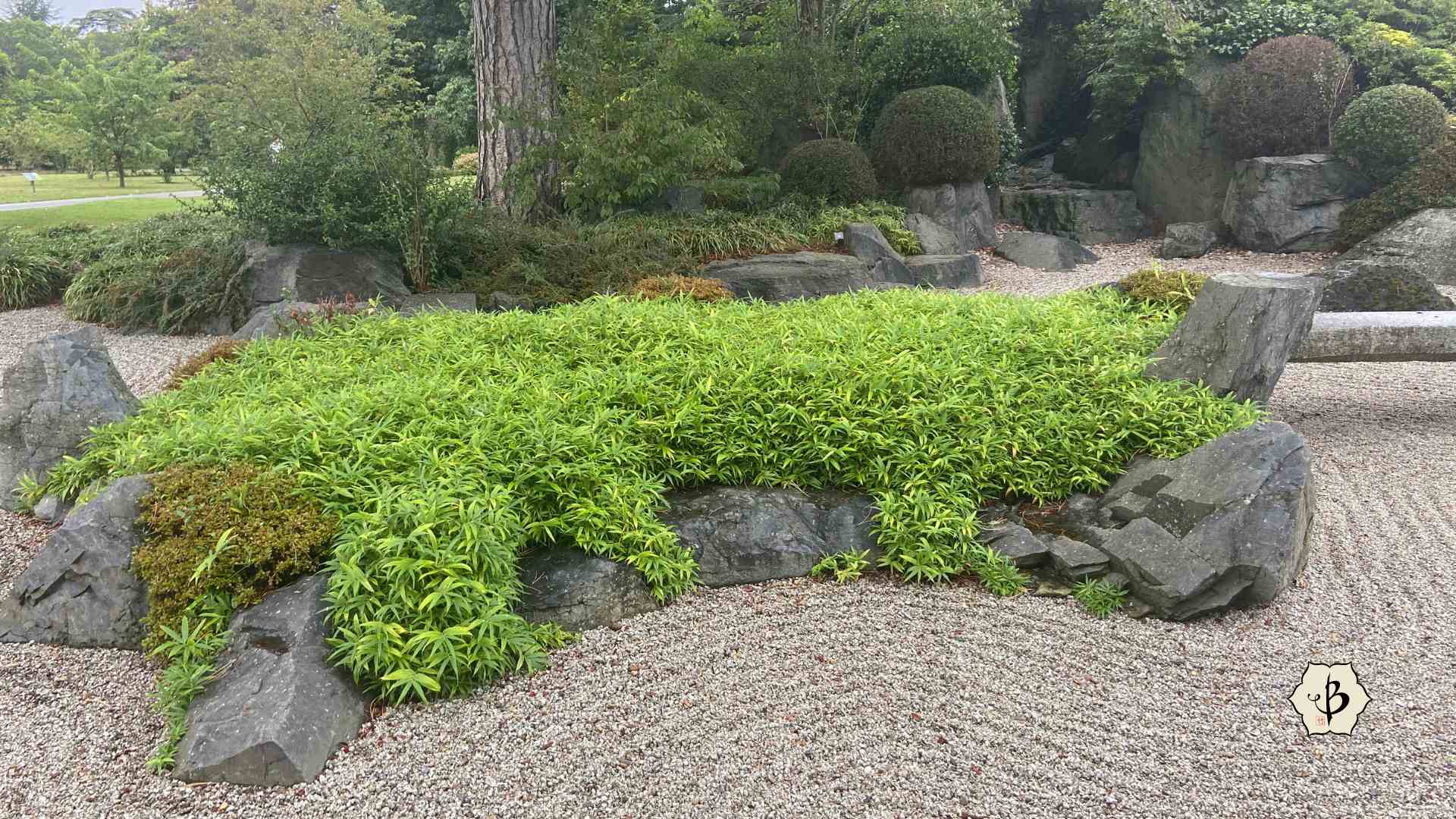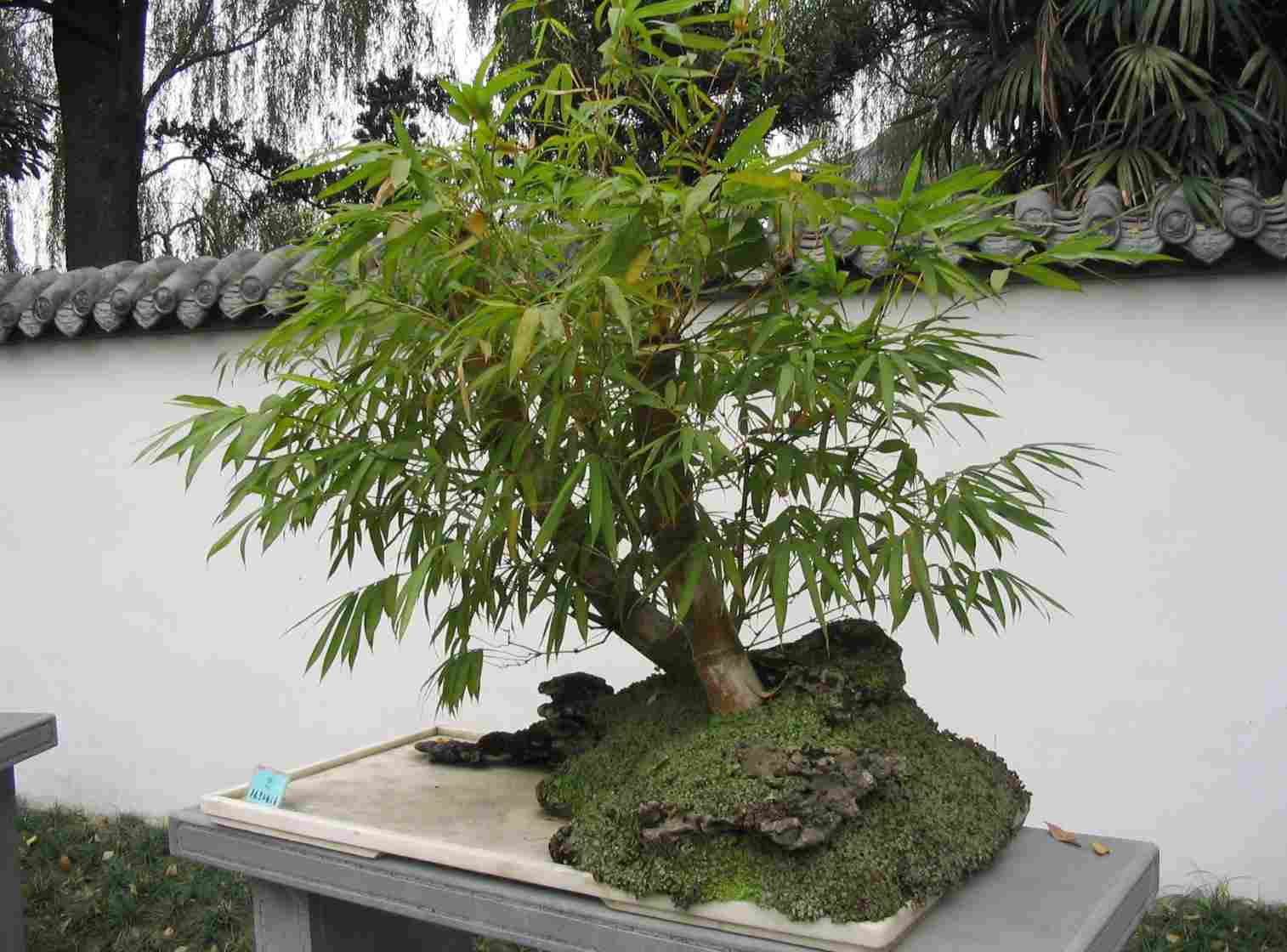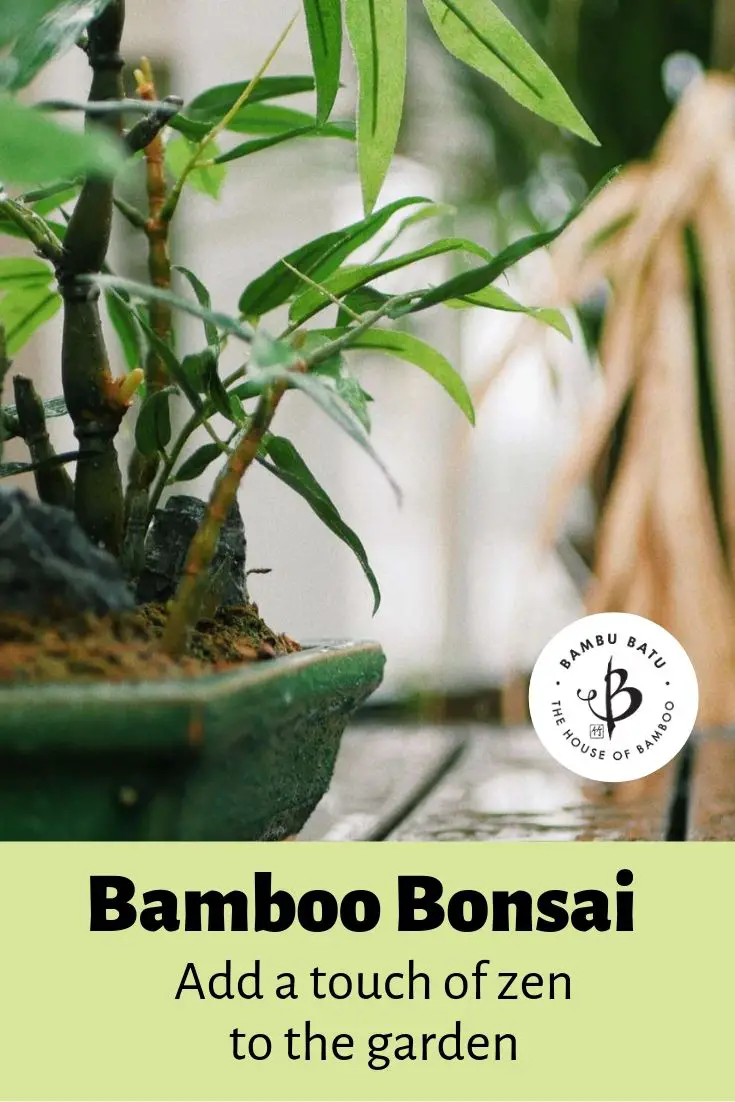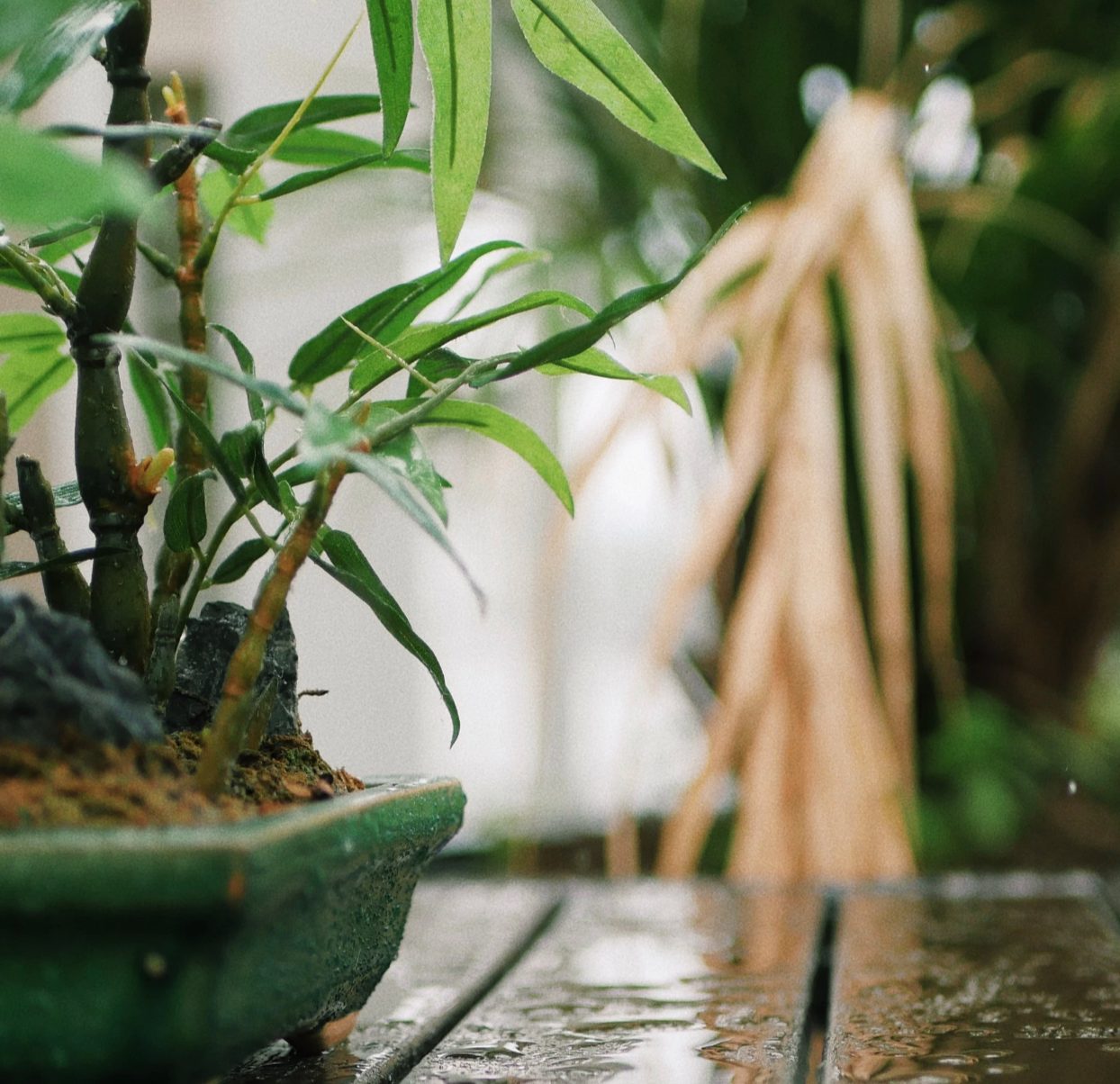Are you looking to add a little touch of the Orient to your garden? Bamboo is one of the best plants to produce that effect. An iconic symbol of the Far East, bamboo embodies all the sublime elegance and simplicity that we associate with Japanese gardens and Asian design.
If you want to take it a step further, you can plant a Japanese maple, whose leaves form a beautiful canopy and turn a brilliant red in the autumn. The Mugo pine also makes an attractive addition, dwarf-like with compact needles. Accent the area with some Mondo grass, also known as dwarf lilyturf, and you’ll quickly find yourself within smelling distance of a deep Zen trance.
But if you’re really serious about your Japanese garden, you’ll need some bonsai trees. Yes, the level of difficulty just took a leap. Maintaining a bonsai can be painstaking work. But keeping a bamboo bonsai is relatively straightforward.
NOTE: This article first appeared in August 2019, most recently updated in September 2024.

Bonsai with Bamboo
Bamboo is easier to bonsai than most other plants and trees. It is remarkably resilient with shallow roots that can tolerate pruning. Compared to keeping something like an elm or a cedar miniaturized, caring for a bamboo bonsai is not difficult at all. It is important, however, to select an appropriate species.
Selecting bamboo varieties for bonsai
If you’re talking about keeping bamboo in a shallow pot that’s only 8 or 10 inches wide, you’ll obviously want to avoid some of the popular varieties of timber bamboo. The ideal candidates for bonsai will have smaller culms and more delicate leaves.
One of the secrets to creating an attractive bonsai tree is finding a specimen that can be miniatured proportionally. For example, if you have a 12 inch tall maple tree with 5 inch wide leaves, it will look a little bit ridiculous. A Japanese maple, on the other hand, has naturally very petite leaves. So when the tree is grown as a bonsai, the small leaves look proportional to the little trunk and branches. Same goes for the Mugo pine, which has very short needles compared to most species of pine.
So if you see a Temple bamboo or an Arrow bamboo, with their long tapering leaves, they might look beautiful in your garden, but they will NOT look right in a little bonsai pot.
There are many dwarf varieties of bamboo, and those are typically the best choices in a bonsai pot. The leaves and culms are naturally more compact, and the roots are unlikely to burst out of the pot in the first six months.
Here are some of the most suitable bonsai candidates to look for.
- A couple dwarf cultivars of Bambusa multiplex are known as tiny fern and tiny fern striped. They generally never grow more than 3 feet tall, with culms less than 1/4 inch thick. Members of the genus Bambusa are also clumpers, so the roots are not going to grow so aggressively.
- Dwarf white stripe and dwarf green stripe are good choices for bonsai, as well. They are very compact species, but belonging to the genus Pleioblastus they are runners, so the roots may require regular pruning.
- One of the most popular candidates for bamboo bonsai is Bambusa ventricosa, also known as Buddha’s belly. Under ordinary conditions this species can grow more than 50 feet, and the dwarf variety usually exceeds 20 feet. But it can be kept in a pot and miniaturized. The stress of being potted actually encourages some of the more interesting characteristics of the Buddha’s Belly. The short internodes sometimes bulge out, looking cute and belly-like, hence the common name. And when stressed or under-watered, a portion of the culms will grow in an irregular, zig-zag fashion, which is very eye-catching.
- Chusquea culeou ‘Hillier’s form’ has short stems and tiny leaves, providing very suitable proportions for a bonsai specimen. The Chilean species has unusually solid culms and is easy to keep short and compact.
- Pleioblastus pygmaeus: Commonly known as Pygmy bamboo, this is another popular dwarf species, with solid, bright green leaves. It generally grows up to about 2 feet high, but can be pruned much shorter, making it an ideal candidate for bonsai. Small hairs on the leaves add some small scale visual interest.
- Pseudosasa owatarii is a cold hardy running bamboo from Japan that only gets about 1 foot tall, with rich green foliage. Because it naturally grows so small, this variety is fairly easy to keep in a small bonsai pot.
- Phyllostachys aurea ‘Waminita’ is a dwarf variety of the common but potentially invasive Golden Bamboo. This more compact subspecies is easy to contain in a small pot and presents a stunningly eye-catching appearance.
Maintaining a bamboo bonsai
One of the biggest challenges with any kind of bonsai specimen is the frequent and meticulous pruning that it requires. But no matter how you’re growing bamboo, you probably need to prune the roots once or twice a year anyway.
Of course, the root maintenance is more intensive when growing running bamboo. Clumping bamboo, for the most part, will spread much more slowly beneath the surface. That’s why clumping varieties (like Bambusa) make good bonsais. And for the same reason, many gardeners try to avoid running bamboo entirely.
But lifting a miniature bamboo out of a bonsai pot is far easier than digging one out of the ground or extracting it from a wine barrel. And you won’t need a Sawzall to get through the burly roots. A nice set of gardening clippers should do the job.
Try taking it out of the pot once or twice a year, before and after the growing season, in the late fall and early spring. Cut back where the roots are spreading the most, and thin them in places where it’s tight and crowded. You can also thin out some of the older culms while you’re at it. Remember, bamboo is a grass; so if you cut back too much, it can almost always recover and put up new shoots.
Chopsticks are another handy tool you can use to feel around the rhizomes. That’s a good way to get an idea of how tight the roots are. If they are very tightly bound, the chopsticks can be used to loosen things up a bit. If the roots are too tight, then the dirt will be impacted, and most of the water will roll off instead of penetrating the soil.
What to expect from you bamboo bonsai
As a grass, bamboo is easier to maintain than a bonsai tree, and the effects will be different as well. By keeping the bamboo in a small container, the culms will never reach full size. So even if you’re dealing with a larger, thicker species, the bonsai version will only only produce pencil-sized culms.
Bonsai growers often take pride in the age of their trees. Bamboo can grow for a long time two. The individual culms will age and die after five or ten years, depending on the species and conditions, but the root ball will endure. Simply remove the aging culms periodically, in order to keep the plant looking healthy and vibrant. Again, this kind of pruning will only encourage fresh, new growth.
Watering your bonsai
One of the most important aspect of bonsai care is watering. It’s critical to remember that over-watering is the number one cause of death among houseplants. But under-watering is the number two cause. So you have to walk a fine line.
When you keep a bonsai plant, you really have to get to know it. You have to be aware of its likes and dislikes, and you practically need to read its mind. Bamboo should almost always stay outside, but in a cold snap it might need to be indoors for a few days. And in a heat wave it may prefer some extra shade.
Also, the amount of water it needs will vary with the weather and the time of year. But in a small ceramic pot, you can typically expect the plant to dry out fairly quickly, needing water every 2 or 3 days. And in the dog days of summer, it will probably need to be watered daily.
Just be sure the water is soaking in and not just rolling off the top. If the water is not penetrating, then poke some little holes in the soil with chop sticks or something similar, and try again. The worst thing you can do is leave your bamboo in standing water or soggy soil for for days at a time. Let the soil drain and dry out between watering, but water it regularly.
Another good idea is to place the bonsai pot near a pond or over a shallow tray of water, just to maintain a little extra humidity around the plant. A little spray bottle can also come in handy for keeping leaves and soil moist.

Easy bonsai additions
Bonsai trees can be amazing and beautiful. But they can also be notoriously difficult to maintain. As a perennial grass, bamboo is far easier to care for than a tree, and it makes a great introduction to bonsai gardening.
If you’re looking for other bonsai accents, but aren’t quite ready to garden like Mr. Miyagi, junipers and ficus plants are some of the easier shrubs to grow in miniature. You can also plant an assortment of succulents into some attractive bonsai pots for a simple and satisfying solution. Just don’t let them overstay their welcome. After a year or so, they too will need repotting, or a least some dividing.
All that’s missing now are the koi pond and a pagoda!
Further reading
To learn more, have a look at some of our other popular articles:
- Pros and Cons of Potted Bamboo
- Dwarf bamboos and ground covers
- Genus Pleioblastus: Bamboo dwarves and accents
- Bamboo for Japanese Gardens
- Growing bamboo indoors
- What’s so great about bamboo?
PHOTO CREDITS: Mark Cruz (Unsplash) and Felix Andrews (WikiCommons)


























